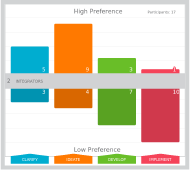The following is an exerpt from independent research, conducted at IBM by Dr. Casimir DeCusatis, an IBM Master Inventor with over 70 patents and co-leader of the IBM Academy of Technology study “Innovation Ecosystems.”
With increasing emphasis on radical innovation as a differentiator, many businesses have begun to invest in building innovation teams without a clear understanding of the specific strategies which make some types of teams more likely to produce useful innovation. We have investigated different structures for teams charged with producing innovative results, including genius teams, improv teams, virtual teams and FourSight teams.
Building More Innovative Teams
It is fundamental that a successful team will include the required skills and expertise to address the problem at hand. This same approach can be applied to the formation of innovation teams.
A more structured approach to building innovation teams involves measuring team members’ preferences and balancing the team accordingly. Because every individual’s personality and temperament differs, their supporting metrics are completely subjective. Instruments such as Myers Briggs Type Indicator (MBTI), Hermann Brain Dominance Instrument (HBDI) and DISC (Dominance, Influence, Steadiness, Conscientiousness) Assessment are some of the most widely known instruments for measuring personality type/ temperament and cognitive thinking. The FourSight Thinking Profile differentiates itself from these instruments by measuring thinking preferences alone.
Innovation requires four distinct kinds of thinking. Most people prefer some over others. The key is training team members to be both self aware and process aware
The FourSight Thinking Profile, unlike psychometric instruments, is comprised of a series of discrete, repeatable steps that people regularly engage in a variety of circumstances. This means its measurement is objective. Further, the breakthrough thinking process is validated as a democratic, universal process by over 50 years of study in the field of creativity and creative problem solving (Puccio, Murdock & Mance, 2006; Ackerbauer, 2008).
The Breakthrough Thinking Process
Because it is an objective measure, the breakthrough thinking process is one we can learn and intentionally replicate. If we can replicate it, we have the potential to sustain, and even scale, the results of breakthrough thinking. The more scalable and impactful our breakthrough thinking, the more innovative people and teams can truly be. While the creative process is universal, each step requires unique mental skills, and most individuals prefer some skills above others. Such biases show up as strong points and potential blind spots when solving problems.
Four Thinking Styles
There are four basic thinking styles recognized by the breakthrough thinking model:
1. Clarify the situation: Clarification requires data gathering, understanding the context of a situation and asking numerous questions. Clarifying a situation can be time-intensive, because it requires a significant level of detail.
2. Generate ideas: Generating ideas, or fluid ideating, requires divergent thinking. Divergent thinking is about looking at the big picture, and playing with potentially abstract concepts that stretch our imagination. Ideation, therefore, requires a more intuitive approach.
3. Develop a solution: Developing a promising idea or series of ideas into a workable solution is about giving ideas the support required to stand on their own. Developing a solution includes comparing and analyzing several noteworthy ideas in order to prioritize and strengthen one or more, then planning for their implementation.
4. Implement a plan: Implementing is nothing more than putting the plan into action. Being able to successfully implement a solution requires persistence and determination. And because implementation generally requires engaging a variety of stakeholders, implementation lends itself to reiterating the breakthrough thinking process.
Unconscious problem-solving styles can create conflict
When teams are aware of their preferences, conflict can be diffused or leveraged as creative tension, producing a potentially more synergistic result. Teams exposed to the breakthrough thinking process have a higher likelihood of approaching problems deliberately.
The more conversant teams are in the dynamics of breakthrough thinking, the more confident they are likely to be in compensating for preference gaps in the strengths of their team. Preference profiling tools such as FourSight can lead to self-awareness of a team’s relative strengths and weaknesses, and provide opportunities to balance the team membership to increase the prospects for long-term success.
Author:
Dr. Casimer DeCusatis, IBM Master Inventor, has over 70 patents and co-leader of the IBM Academy of Technology study “Innovation Ecosystems.” This article was an exerpt from a research article published in “Creativity and Innovation Management,” which explores the most effective way to support innovation in teams.
References:
Ackerbauer, M. (2008) FourSight and the Breakthrough Thinking Process. Proc. 2nd Innovation and Creativity Management Community Meeting, Buffalo, NY.
DeCusatis, C. (2008). Creating, growing and sustaining efficient innovation teams. Creativity and Innovation Management, 17(2), 155-164. To read the complete article, please go to FourSightOnline.com and click on “Blogs.”
Puccio, G.J., Murdock, M.C. and Mance, M. (2006) Creative Leadership: Skills that Drive Change. Sage Publications, Thousand Oaks, CA.
IBM Case Study in FourSight Teams
Dr. Casimer DeCusatis, IBM Master Inventor
Although the FourSight Thinking Profile does not predict performance, it does provide awareness of how teams would otherwise prefer to perform given the appropriate environment. FourSight has been administered to almost 300 people within IBM. Approximately half of those have been debriefed in a formal workshop where the breakthrough thinking process was described and explored at length. In such workshops, participants are taught the breakthrough thinking process and then given their survey results. The remainder of the workshop consists of a detailed breakdown of each of the four elements of breakthrough thinking by preference name (Clarifier, Ideator, Developer and Implementer), and an introduction of critical thinking tools for leveraging that preference.
The performance of this IBM team [see graph] bears out the profile, in that there was a great deal of challenge exploration and a rich forum for sharing thoughts and ideas during the study meetings. However, when it came to taking action and submitting the sub-team findings, there was more emphasis on ensuring ideas were captured in raw form than in a coherent summary of findings and recommendations. A series of late revisions addressed this lack of preference in idea refinement (note this is an implementation statement, proving that preferences do not necessarily predict performance). Education on how to prioritize and evaluate ideas, followed by driving them to closure, would have proven valuable to this team. By providing this type of preference list as part of a debriefing session, teams have immediate awareness of collective strengths, and are compelled to engage other team members so as to augment their preference gaps in the breakthrough thinking process.

The IBM team in the FourSight profile above shows a high preference for ideation and clarification, and relative low preferences for development and implementation. This suggests the team has a propensity to generate relevant ideas, yet may lack energy for developing and implementing strong solutions.




